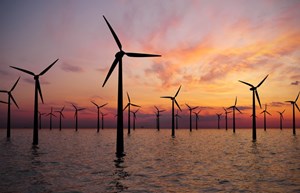OTC 2024: One firm’s journey beyond the barrel with offshore wind
During a panel on Tuesday, May 7, Day 2 of OTC 2024, Celine Gerson—President and Group Director of Fugro’s U.S. business—offered insight into the company’s journey to becoming a key geophysics data player. As Gerson noted, the impact of access to electrical power—particularly in the developing world—is profound, and with the global population projected to grow 25% by 2050, that fact is more urgent than ever.
Diversified focus. For Fugro, the increasing demand for reliable power, as well as the concerns of sustainability and environmental responsibility, required the company to make a shift. Gerson mentioned that 85% of the firm’s 2015 portfolio was composed of oil and gas, which shortly after made for dire financial straits in the uncertain 2016 market that followed the price collapse of 2014.
The financial conditions prompted a serious change in business strategy to promote stability and endurance, and the company opted to diversify, rather than wait out the market or pivot completely to another industry altogether. As a result, Fugro has since split its focus fairly evenly among three market verticals: traditional energy, renewable energy sources, and infrastructure and construction—both onshore and offshore.
Pursuing data and skill sets. The common thread between Fugro’s current and prior business focus is geological data. Traditionally, these data would have been used almost exclusively for offshore oil and gas. But in the company’s move to diversify, Gerson noticed how relevant these data could be in other areas—particularly infrastructure.
Referring specifically to the offshore wind industry, for example, she said, “[a]ll the skillsets [of the traditional energy space] are highly relevant.” Indeed, Gerson pointed out, the offshore wind sector in the U.S. has seen a positive shift, with 12 new offshore leases announced for the 2024–2028 period. This is added to a previous 2022 announcement of $3.5 million in grant funding, to aid in reaching 30 GW of energy production by 2030. Previously, the future of the industry did not have the kind of “line of sight” necessary to encourage investment and growth, owing mostly to uncertainty surrounding agreements made pre-Covid.
Even with the new opportunities, there are several “pain points” that Gerson highlighted when it comes to implementing offshore wind at scale in the U.S. They make it difficult to take advantage of the new leases. First, “[t]here is now a very big focus on developing the supply chain [and] the skillset to bring clean energy to the United States,” she pointed out, as well as the proper types of infrastructure and supply chains to support any operations.
From infrastructure for blade maintenance and assembly, to harbors equipped for large transport and installation vessels, to high-power electric infrastructure to fuel these operations, the U.S. East and West Coasts are not yet equipped for large-scale offshore wind. However, “[t]he biggest, trickiest part…is the design for those floating wind structures,” Gerson warned, adding that ambitious—and even efficient—designs can outstrip the limits of transportation.
In closing, Gerson laid out a common energy transition woe: “[i]t’s easy to put a transformation plan on paper, but it’s harder to execute.” Offshore wind—as with any energy transition-related industry—requires a balancing act. Older, more established fields within oil and gas need to be included in the discussion, where newer industries can make use of their existing skill sets. New talent also needs to be attracted, said Gerson, who highlighted the fact that “[w]e in the energy industry don’t always have attraction for the talent of the future,” due in part to the fractured narrative that results from many individual companies speaking at once. Changing this, she asserted, would require “com[ing] forward with one voice,” perhaps through a central means of communicating industry topics to the public.
Finally—perhaps the most critical point—Gerson asked a question: “Does the journey you’re making make sense from a business standpoint? Does it stick with the investors?” Energy transition needs to be a purposeful decision, she said, and companies “need to walk the talk,” if they intend to take that course. If so, success will come down to three things: making use of skill sets relevant to both traditional and renewable energy sectors, thinking and acting in light of how energy demand will grow, and collaborating as much as possible, so that operations don’t have to “reinvent the wheel” and can, instead, forge ahead with proven technologies.



